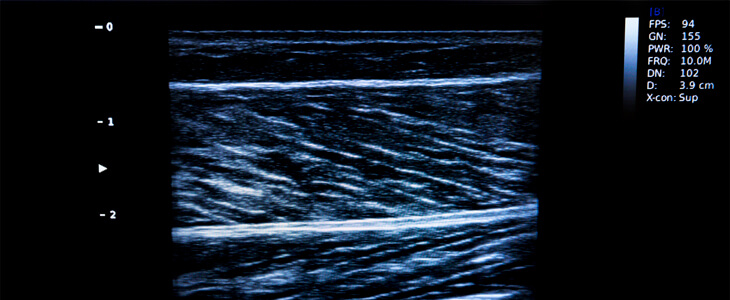At Long Island Rehabilitation Medicine, a first-rate practice with a number of offices in Nassau, Suffolk, and Queens Counties, we are committed to treating patients with spinal and other musculoskeletal problems with innovative, non-invasive treatments. Our doctors have impeccable credentials; they are not surgeons, but rather physiatrists — physicians who specialize in pain management and rehabilitation. Musculoskeletal ultrasound is an integral part of our practice since we use it both diagnostically and as part of our treatment administration.
Musculoskeletal ultrasound is basically an imaging technique that adds a new dimension to the traditional types of diagnostic tests like X-rays, CT and MRI scans. What differentiates ultrasound imaging from the others is that it uses sound waves to produce pictures of soft tissue throughout the body.
What does musculoskeletal ultrasound help us to diagnose?
Patients come to us with a wide variety of ailments, and in many cases musculoskeletal ultrasound helps us to get to the root of their problems. The technique assists us in diagnosing:
- Sprains
- Strains
- Tears in tendons or ligaments (e.g. rotator cuff injuries)
- Entrapped (pinched) nerves, such as carpal tunnel syndrome)
- Ganglion cysts
- Benign and malignant soft tissue tumors
- Osteoarthritis
- Rheumatoid arthritis
Musculoskeletal ultrasound is extremely sensitive, identifying synovial cysts and stretched and torn ligaments that may be indicative of osteoarthritis, as well as the inflammation of the joints common to rheumatoid arthritis.
How is musculoskeletal ultrasound used as part of treatment?
Because the images produced by musculoskeletal ultrasound are so distinct and the process is so simple, this method of imaging is also successfully used to guide injections we used to treat pain and inflammation.
In much the same way spinal injections are administered under fluoroscopic guidance, injections to joints in other parts of the body are administered under ultrasound guidance.
Musculoskeletal ultrasound serves the purpose of increasing the accuracy of such injections, ensuring that the medication, typically corticosteroid and painkiller, is placed in precisely the right spot. Injections administered in this way have been found to be more effective than those administered without the assistance of ultrasound imaging.
How does it feel to undergo ultrasound?
As anyone who has been pregnant during the past many decades will tell you, ultrasound is safe and painless; it may even feel pleasant. Occasionally, patients experience minor discomfort as the doctor applies a bit of pressure to get a clear picture.
The doctor rubs gel gently over the skin of the targeted area to facilitate the process. Then, a transducer (a small probe) is moved over the region being investigated and the high-frequency sound waves the transducer emits travel through the gel into the body.
The probe collects the sounds that bounce back and a computer uses them to create detailed images. This shows the structure and movements of internal organs in real time; even the blood flowing through blood vessels becomes visible. Depending on the part of the body being investigated, the patient may be seated or lying down and may be asked to change position during the exam.
After the doctor finishes with the muscular ultrasound, the remaining gel will be wiped off the patient. There will be no aftereffects and the patient can return to routine activities immediately afterwards. For most patients, this test takes only 15 to 30 minutes to complete.
Advantages of Musculoskeletal Ultrasound Over Other Imaging Techniques
Musculoskeletal ultrasound has a great many advantages over other imaging modalities, including that it is:
- Noninvasive
- Almost entirely painless
- Widely available and easy to use
- Extremely safe, using no radiation
- Much less expensive than MRI and CT scans
- Able to provide a clear picture of soft tissues (not available on X-rays)
- Able to show images in real time so it can be used to guide injection administration
- An excellent alternative to MRI scans for patients who are claustrophobic
- Able to be used safely on patients who pacemakers and other implants that may be adversely affected by the strong magnetic field needed for MRI scans
- Does not require holding extremely still so that it can be used successfully on babies and small children without sedation
- Provides great clarity of images of cartilage than other methods
Musculoskeletal ultrasound is not, however, perfect and is not always superior to other imaging methods for all purposes. It is not useful, for example in diagnosing whiplash or most other causes of back pain. Also, because sound waves penetrate less deeply than other X-rays, it does not show clear images of deeper structures within the body, especially in larger patients.
Long Island Spine Rehabilitation Medicine Offers Cutting-Edge Diagnosis and Treatment
If you are suffering from undiagnosed spinal or musculoskeletal pain, making an appointment with one of our experienced professionals may be the smartest step you’ve taken in a long time. We use the most up-to-date equipment available, the same devices used by the NBA, the NFL and the U.S. military.
We have a comprehensive knowledge of our areas of expertise and are dedicated to relieving your pain and increasing your mobility with noninvasive treatments. Come to one of our conveniently located offices; we have the superior skills and genuine concern you’re looking for.
